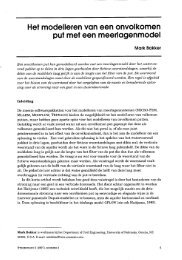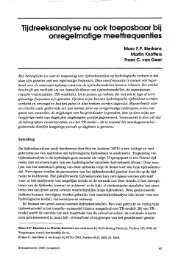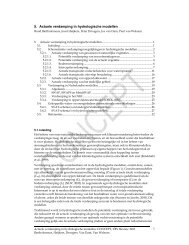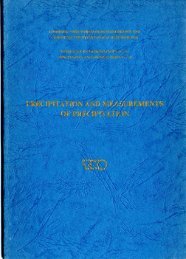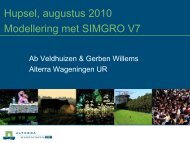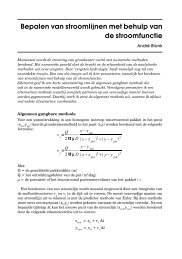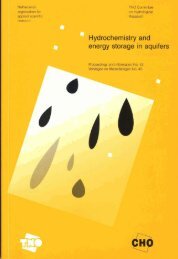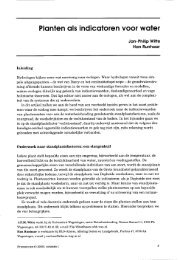Hydro-ecological relations in the Delta Waters
Hydro-ecological relations in the Delta Waters
Hydro-ecological relations in the Delta Waters
You also want an ePaper? Increase the reach of your titles
YUMPU automatically turns print PDFs into web optimized ePapers that Google loves.
In Tahle 3 a tentative carbon budget of <strong>the</strong> 4 sal<strong>in</strong>e <strong>Delta</strong> <strong>Waters</strong> Is<br />
given. as an expression of <strong>the</strong> transfotmation of <strong>in</strong>organk nutrients<br />
<strong>in</strong>to organic carbon of primary pxohcers. Table 3 does not girre<br />
<strong>in</strong>fetmatioa about <strong>the</strong> turnover of nutrients between <strong>the</strong> successive<br />
generations of plants. Notwithstazdlng <strong>the</strong> large dlfkrences <strong>in</strong><br />
nutrient loadjags of <strong>the</strong> separate waters, primasy production of<br />
phytoplankton only shows a difference of a factor 2 between <strong>the</strong> light<br />
-2 -1<br />
limited, tUrbid Westerschelde (l25 g C m y ) and <strong>the</strong> clear,<br />
-2 -1<br />
presumably not nutrient limited Veerse Meer (249 g C m y ). The<br />
Oosterseblde and Orevel<strong>in</strong>gemseer hold <strong>in</strong>t-diate positions.<br />
Production of microphytobent!hos (benthic diatoms, gzeen algae etc.) is<br />
roughly one third of <strong>the</strong> production of phytoplankton. In <strong>the</strong><br />
Westerschelde estuary, however, <strong>the</strong> relative skre of benthic<br />
microphytes is considerahLy higher, based on P/B ratio's derived from<br />
high biomass data, taken on <strong>in</strong>tertidal flats (personal eonrmnaicatFoa<br />
D.J.<br />
de Jong, DW).<br />
OwFng to <strong>the</strong> relatrvely large surface area of supratidal wetlands, <strong>the</strong><br />
contributivn of ahoae-ground peimarp production to <strong>the</strong> carbon budget <strong>in</strong><br />
-9 -1<br />
Westersehelde estusry (60 g C m y is about 20%. The larger part of<br />
<strong>the</strong> saltmarsh plants is produced <strong>in</strong> <strong>the</strong> eastern secrion of <strong>the</strong><br />
Westerschelde estuary (Verdrmken Land van Saeft<strong>in</strong>ghe) and is not<br />
transpwrted over <strong>the</strong> entire estuary, In contrast with <strong>the</strong><br />
Westerschelde, <strong>the</strong> Oosterachelde salt marshes pay only an <strong>in</strong>significant<br />
contrLhution (lees thau 5Z) to <strong>the</strong> system metabolism of <strong>the</strong> entire<br />
estuary.<br />
Maarophytes grow<strong>in</strong>g on bard substretes (i.e. seaweeds attached to<br />
sewalls and stone-clad dilres) have only a m<strong>in</strong>or contriburian to <strong>the</strong><br />
carbon budgets of <strong>the</strong> entire water hobtes, notwithstandiag <strong>the</strong>ir high<br />
production per square metre habitat.<br />
Eigh turbidity and exposure to waves and tides prevents <strong>the</strong> potential<br />
sediment habitats <strong>in</strong> tke Weatersehelde egtuary from be<strong>in</strong>g <strong>in</strong>vaded by<br />
macrephytes, The Oosterschelde estuary has only local growth of<br />
laactophytes an sediment substrams <strong>in</strong> sbeltered regions (Zandkteek,<br />
Ktabbenkreek, eastern part). In <strong>the</strong> sheltered, stagnant lagoons





